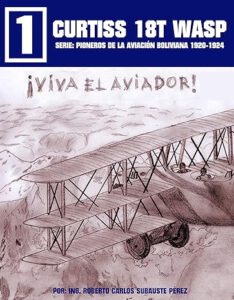Mr. Subauste Perez did in depth research on the roots of Bolivian aviation. Virtually every aspect is covered by this series of books of which the story of the Curtiss 18T Wasp (T for Triplane) is the first. This book covers the origin of this aircraft, its history in a general context, the Bolivian connection, a thorough technical description of the airframe and engine, and as a background the socio-political situation of contemporary Bolivia. It also puts Bolivia in the general history of the surrounding South American countries.
However for an aviation adept the story of the Curtiss Wasp, the intricate detailed explanation of its capacities and performance attracted me the most. Especially the experiments with this and successive aircraft at the altitude of La Paz, 3800 mtr (!) are described to a sobering reality. The then weak engines and the inadequate airframes of First World War aircraft technology were doomed to fail. Which they did, to the detriment of most of the aviation pioneers who flew these planes. Flying at altitudes of 15.000 ft / 5000 mtr was possible with these planes, but manoeuvring at low speed and understanding of stall speeds and recovering from a low level spin in thin air was still largely unexplored territory.
The hero of this story is American aviator Donald Hudson, certainly an intrepid flyboy. During WW I he became an ace with 6 victories and earned a Distinguished Service Cross. Postwar he was part of a contract for a specially built Curtiss 18 T Wasp Triplane, accompanied by his wife and two mechanics, to start up an aviation school for the Bolivian Air Force. His most famous accomplishment was the first aerial crossing of the Andes. Unfortunately, not much later he crashed the Triplane. Hudson survived, never flew again and lived to old age (1967).
The code of this book centers on the start of Bolivian aviation. All the prominent Bolivians of this first hour of flying aeroplanes in the thin Bolivian air are mentioned and their unstoppable enthousiasm which made it possible that in about four years time the first Bolivian pilots emerged from their own aviation school at Palo Alto. Mr. Subauste Perez certainly deserves credit for this book, and the following books, about the cradle of Bolivian aviation.









Leave a Reply